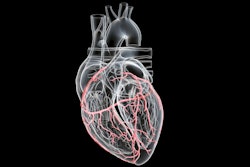CT could be the preferred method for younger patients in cardiac outcomes related to major procedure-related complications, according to research published February 28 in JAMA Cardiology.
A team led by the DISCHARGE Trial Group found that while age does change the effect of CT and invasive coronary angiography (ICA) on the outcome of major adverse cardiovascular events (MACE), it does modify the effect of these techniques on major procedure-related complications. The team reported that CT is tied to a lower risk of major procedure-related complications in younger patients.
“The findings emphasize the importance of further investigations into the effect of age in the evaluation of patients with stable chest pain,” the group wrote.
While ICA is an established technique for diagnosing and treating obstructive coronary artery disease (CAD), coronary CT is a noninvasive alternative for ruling out obstructive CAD in patients with stable chest pain.
However, choosing between the two can be difficult, the researchers noted. Age is a cardiovascular risk factor, but it is not well known whether it should be a factor in deciding between ICA or CT.
Using data from the Diagnostic Imaging Strategies for Patients with Stable Chest Pain and Intermediate Risk of Coronary Artery Disease (DISCHARGE) trial, the researchers evaluated how age could play a role in choosing between ICA and CT. They measured age’s effect on the rate of procedure-related complications of the two techniques.
The group included data from 3,561 patients with an average age of 60.1. Of these, 2,360 (66.3%) were younger than 65, 982 (27.6%) were between the ages of 65 and 75, and 219 (6.1%) were older than 75. The patients were randomly placed into CT or ICA groups.
The researchers found that modeling age as a continuous variable, age, and randomization group were not significantly tied to MACE. This included a hazard ratio of 1.02 (p = 0.31 for interaction).
The group also reported that age and randomization group were linked to major procedure-related complications. This included an odds ratio of 1.15 (p = 0.005 for interaction).
Overall, CT was tied to a lower risk of major procedure-related complications in patients younger than 65. Also, patients ages 65 to 75 had a “possible but uncertain reduction” in major procedure-related complications in the CT group, while patients older than 75 in both CT and ICA groups experienced similar rates of major procedure-related complications.
The study authors highlighted that their results suggest CT is a beneficial modality for younger patients. This is due in part to younger people having a lower rate of obstructive CAD and being less likely to be referred for ICA after an abnormal CT.
“The low rate of events with the use of a CT-first strategy was attenuated in older patients who are more likely to have CAD and therefore to need ICA after a positive CT,” the authors wrote. “Of note, in the CT-first group, major procedure-related complications occurred more often with increasing age, whereas in the direct-to-ICA group, the proportion of procedures with a complication was similar across all age groups.”
The full study can be found here.




















